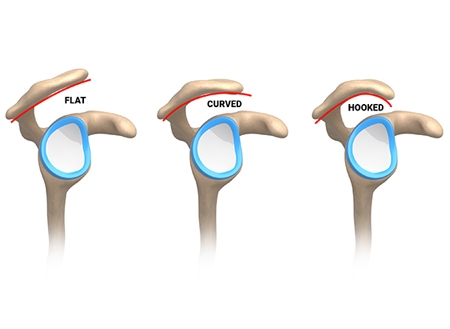The shoulder is a complex joint that is capable of a wide variety of functions due to the ball-and-socket nature of its make-up. The devil is in the details when it comes to the shoulder. One of those details is the acromion. The acromion is the prominence of the scapula that meets the end of the clavicle to form the acromioclavicular joint. This joint can look a little different in everyone because different types of acromion exist. Let’s explore.
Three different types of acromion shapes exist. The first of these shapes (and also the most common) is a Type I acromion, which has a relatively flat undersurface. Alternatively, a Type II acromion involves a curved contour whereas a Type III acromion has a more hooked shape. The type of acromion a patient has can be seen on a plain film x-ray, which is one of the many reasons that our physicians start with x-rays of the shoulder when a patient comes in for a shoulder evaluation.
Now you are probably wondering how different types of acromions affect the general functioning of the shoulder joint. People who have Type II and Type III acromions are more likely to experience impingement syndrome of the shoulder. This is because the tendons of the rotator cuff muscles pass through the already narrow region underlying the acromion. If you have a Type II or Type III acromion, that region is even more narrowed; thus, making you a prime candidate for impingement syndrome and the pain it produces. Curved and hooked acromions can also increase the risk of sustaining a tear in one of the rotator cuff tendons.
To manage symptoms associated with shoulder impingement syndrome, your physician will likely recommend formal physical therapy, or at least a dedicated home exercise program, to help improve the mechanics of the shoulder and scapula. When these structures work in unison, a patient is less likely to experience pain. If symptoms are more moderate, your physician may recommend a cortisone injection. Getting the steroid directly into the inflamed and irritated space can also help alleviate pain, though improved shoulder mechanics is what will keep your symptoms at bay long-term. Lastly, the most invasive treatment option would be surgery to either remove the end of the clavicle (called a distal clavicle excision) or to remove bone from the underside of the acromion (called an acromioplasty). This surgery in and of itself is minimally invasive and typically involves a brief recovery. However, it is also done in conjunction with other procedures such as a mini rotator cuff repair or biceps tenodesis (stay tuned for more on that one!).
Regardless of the severity of your symptoms, plenty of treatment options are available for whatever type of acromion your genetics have given you. Just give our office a call to get set up with one of our shoulder specialists today!

